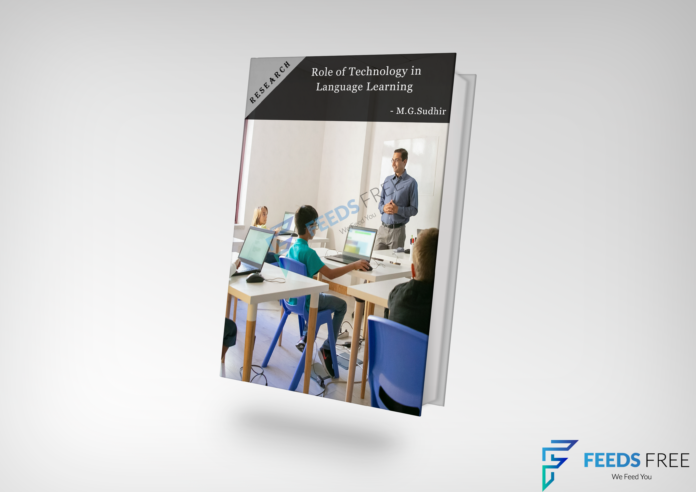Table of Contents
- Abstract
- Chapter 1 – Introduction
- Chapter 2 – Using CALL in Language Learning
- Chapter 3 – Use of Media in Language Learning
- Chapter 4 – Use of AI in Language Learning
- Chapter 5 – Conclusion
- PDF – Download
- View Appendix / Research Question
Abstract
In this project, I have explained the role of technology in education and detailed the use of major tools in language learning. In the introduction chapter, I detailed the history of the development of technology into the classroom and its role in the development of language learning. In this chapter, I explained technological involvement in students and teacher’s daily life. In the second chapter, I explained CALL, its uses, and how to use CALL tools. By reading this chapter reader can gain knowledge about using computer-assisted language learning (CALL). In the third chapter, I detailed the use of media, digital media and social media in language learning. So, the reader can gain information about the uses of media in language learning and education. In the fourth chapter, I explained the use of AI in language learning reader can get the different AI using tools in the educational field and how it develops language learning. And finally, in the conclusion, I concluded the use of CALL, Digital media, social media, AI and I debriefed the responses received to me in the digital form, which I shared the form in digital media platforms to get responses. In the end, this thesis reader can gain the maximum knowledge of technological use in language learning and education.
Introduction
Technology has always been an important part of the teaching and learning environment. Students tend to show more interest in subjects when technologies are integrated, it provides the opportunities to make the learning fun and enjoyable, it was seen to attract students to learn new things. If a teacher teaches his student through games, quizzes and polls, virtual trips, and other online resources, students can understand and learn better than in non-technological (physical) classrooms. When a student learns on the digital method, it encourages the student to be involved with his studies. In beginning wooden paddles with printed lessons are used to teach students in the colonial period. Then, a slide projector called magic lantern was invented which projected glass-printed slides. In 1980, chalkboard became famous in schools and in 1900 pencil, in 1920, radios began to take air-classes, in 1930, overhead projector, in 1940, ballpoint pen, which makes writing easy for the students, in 1950, headphones, in 1951, videotapes invented and began to give birth to the new era, in 1959, the photocopier was invented, in 1972, modified calculated was invented by seeing these developments we can see the development of technology and hungry of students for development of technology in the learning field.
Technology has changed the role of students and teachers because in the traditional way of learning sources are limited, teachers are the only primary sources to acquire information for the students. By implementing technologies into the physical classrooms helps the students to improve engagement. Students can improve their knowledge retention and learn individually that encourages collaboration and developing life skills.
According to Bill Gates (Co-Founder of Microsoft) “Technology is just a tool. In terms of getting the kids working together and motivating them, the teacher is most important .”
He tells that technology can only be a tool for the kids to work together and to motivate them but a teacher is the most important person who can mentor them and teach them. At present, students don’t need to wait half to one hour for website loading time. Technology provides access to many resources instantly. Once students are used to taking bulk textbooks to their schools and colleges but now most of the textbooks are available on the internet and can easily be accessed through computers, tablets, and smartphones. The technology eliminates the boring part of the study. Also, a student can be tracked and graded by software, and it also creates collaborative learning. If a student learns through lecture, he can only obtain 20-30 % of information but using technology, a student can obtain 70-80 % of information through the internet. Using technology, a student can obtain many additional skills like learning, writing, communication, and technological skills. Teachers can use technology to collect data about students, materials, books on a single device. Students can work in their comfort zone and technology provides opportunities for the students to improve skills in other or related subjects, it can motivate students to learn more and explore. We can assure that our information is up to date and students can use a search engine like Google, Bing, DuckDuckGo to verify.
Teachers can use technology to study and experiment with the students. They can understand students and knows their ability, they can change the teaching method according to the student’s field of interest. As mentioned earlier technology can be helpful for both teachers and students. A teacher can understand a student by analysing him with the digital and technical tools and the student can be encouraged by his teacher to actively participate in the classroom. Every student has his own mindset, hobby, learning, and his own abilities, and we cannot expect all students will learn in the same way.
If students use technologies to learn, it provides great opportunities for the students to learn effectively, for every student with different needs and different abilities. Technology can provide more support and opportunities for the students who struggle to learn. Technologies will be more helpful for physically challenged students. Students who have access to the internet have access to a broad range of resources, with the help of the internet and technological devices students can practice collaboration skills like collaborating with other classes or other intuitions around the world. Implement of technologies in classrooms will help to develop both teacher’s and student’s skills. At present, learning is about collaborating with other skills, and every student must know any of the technical skills to survey. Teachers can also use technologies to read their students and they can prepare with countless online sources. Blended language learning is easy if a student can’t attend the physical class. With the evolution of technology in language learning, we can see the domination of technology in everything.
The Covid-19 Pandemic showed us that development in the learning process is possible even when we are not able to present in the physical class. It was proved that we can learn, teach classes online, write exams and tests in the software. Teachers can send assignments and materials through google classrooms, mails. We can’t tell that digital and technical method in learning is not possible if we take the survey the result will show that students and teachers use mobile phones, tablets, laptop, PCs, and television. Even when many students couldn’t these facilities they can afford a radio and TV the government initiated television programs for those students who can’t afford mobile phones and other digital devices. By using technology teachers can teach physically challenged students by projecting sign languages and by audio clips. This development helps the EFL (English as a Foreign Language) students to improve their English language skills by using language labs, listening to English movies, series, etc. Technological development in Foreign language learning was very revolutionary, most teachers and learners know how to use or operate the technical devices. Nowadays it’s rare to find a language class that doesn’t use some form of technology. In language classes, technology has been used for both assisting and enhancing teaching and learning. Teachers are trying to use and incorporate technologies to teach their students. By using this technology remote language learning is possible, the main aspect of technology is its ability to reach audiences all over the world, so anyone can learn any language from the native language speakers, without technological development language teaching is limited.
In the book, Integrating Technology Into the Curriculum by Shelly Frei, Amy Gammill, and Sally Irons, they explained the history and development of technology into the learning process and implementing it into the curriculum. They also explained every method of teaching with and without technology including advantages and disadvantages in it.
The rapid development of information and communication technologies (ICTs) has had a profound impact on language education where interaction has been a central concept since the 1980s, both in sociocultural and cognitive approaches to learning (Lamy & Hampel, 2007). The virtual learning environment has been developed and makes a better way to communicate and strengthen the relationship between the students and teachers. Weller’s (2007) definition of a VLE as ‘a software system that combines several different tools that are used to systematically deliver content online and facilitate the learning experience around that content. Even the student who was not able to afford amount or without the formal qualification or from an excess age group are allowed by many open university lectures or anyone can attend seminars or assignments and provide with the tutorial, this also includes with face to face tutorials. Open Universities have designed interactive and conventional distance language courses and include audio conference synchronous, asynchronous tools for language learning. By exploring the tools like blogs, wiki, websites, and forums can obtain more information, but many students are not aware of such tools and materials. In the book, Tasked-Based Language Learning and Teaching with Technology, edited by Michael Thomas and Hayo Reinders, they talked about CyberDeutsch projects collaborative learning, learning objectives, learner preference, tutor role. The project CyberDeutsch aimed to be learner-centred, collaborative language learning. The experiment of providing students with a collaborative environment and providing them scope in organizing their own, this project shows that students can’t coordinate and study for themselves even they used technologies there must some mentor to lead them.
In the book, second language teaching and learning with technology edited by Sylvie Thouësny and Linda Bradly, they created a project named eBook project. They targeted the young research scholars who completed or nearly completed their Ph.D. It was studied by the two young Ph.D., Scholars in the idea of making eBooks free for the seekers. For verifying the quality of chapters, there has been a reading committee created consisting of seven prominent senior CALL researchers together with the two editors.
At the beginning of CALL (Computer Assisted Language Learning), an audio-lingual method was used to teach grammar and Phonetics. CALL is transformed into TELL as a Technology Enhanced Language Learning, CALL changes both teachers and learners’ teachers indirectly involves in the student’s construction of language by creating online activities and students can enhance their ability using CALL. TELL is now preferred in many educational intuitions, they create a unique environment and gives the flexible way of learning style, TELL can be along with textbooks.
According to Chapelle & Jamieson “the area of applied linguistics concerned with the use of computers for teaching and learning a second language”(Chapelle and Jamieson, 2008)
By experimenting with many methods, it led to the beginning of CLT (Communicative Language Teaching) in the 1970s, CLT can make fluency in languages learn, we can understand the meaning of new languages, communication can be stronger by using activities and learners can directly converse the language with the native speakers. CLT also used in foreign language learning classes and second language learning environments, in foreign language learning the teachers are non-native speakers, they feel more comfortable in teaching grammars and words but they can’t teach the slangs and pronunciations, CLT is also used in the second language teaching and learning, here learners can learn the target language outside the classrooms. By using technology we can solve many issues in language learning especially today’s interconnected world by digitalization.” As educational and political institutions in various countries become more sensitive to the importance of teaching foreign languages for communicative purposes (not just to fulfil a ‘requirement’ or of ‘passing a test’), we may be better able, worldwide, to accomplish the goals of communicative language teaching” (Brown, 2001)
According to Levy “the search for and study of applications of the computer in language teaching and learning” (Levy, 1997)
Warschauer divided the history of CALL into three phases first phase from 1970 to 1980 as a structural, in this time learners started to learn the use of mainframe computers for grammar practice, the second phase from 1980 to 1990 as a communicative, during this period computers were used for communicational exercises to encourage the fluency of language and third as an integrative from 21st-century it is the era of development of technology and digitalization, now we can use many devices to learn languages, we can connect easily to the native speakers and improve our language and linguistics skills. Davies, Walker, Rendall, and Hewer (2012) renamed the stages of Warschauer, 1970 to 1980 as a Dumb CALL, during that time there is lack of visualization and audios,1990 as a multimedia CALL, time of multimedia development and 1993 to present as a web CALL, in 1933 web activities was started, started to develop interactions like videos and sounds.
As pointed out in the 2010 version of EUROCALL’s Research Policy Statement, “[r]esearch in CALL has been carried out for more than thirty years and has now reached a significant level of volume and maturity. It is a truly international discipline and has led to notable improvements in the teaching and learning of languages in secondary and higher education institutions worldwide”
In the book Second Language Teaching and Learning with Technology the authors explore the Reading and Learning Vocabulary Independently with the help of CALL and NLP (Natural Language Processing) technologies, in the area of foreign language instruction independent learning is used in connection with computer technologies, they portray CALL as a money saver and as an easy way to form an independent learning environment. CALL as a money saver in their book, in the beginning, both software and hardware rate are high, in the beginning, both software and hardware rate are high but the infrastructure of CALL in the universities are ready and they also explained that it will not affect the teachers.
Technology changed our old method of learning, Nowadays most of the students aren’t carrying their textbooks and large bilingual dictionaries to learn languages, we can find a sea of resources on the internet to help anyone, who wants to learn a new language although there are many resources available in online but we need teachers and mentor to guide the students. Digitization made the resources easily accessible; we can’t carry our books and materials everywhere. So digitalized e-books and online materials can be easily accessed anywhere we want, digitized dictionary made it easy for language learners. In this everyone can have access to the internet in the present days, so they can use the dictionary whenever they want. Dictionaries and hyperlinked texts are some of our first inventions in digitization. Websites like Google gives us the definition of every word.
We are living in the world of many languages; multimedia plays important role in this multi-language world and foreign language learning. We can also see the accompany of multimedia in the early period by CD and the other form of audio and video resources. In this era couches with the audio file of native language speakers will help the new language learners can feel the slang and fluency of language, if the learners listen to the native way of speaking, they can understand the language very clearly.
Many digital dictionaries are included with audio files, this will help the language learning students to understand the word with pronunciation. Multimedia also includes video files, it helps the language learners to analyze the lip movement and slang of the native language speakers, there are many platforms which offers free online course like Udemy, YouTube. Technology made everything simple like typing also include in it because of auto-correcting and some plugins, today we can find the auto-correction in every software and websites, it was auto-enabled and free to use, So if a student tries to learn a new language but he doesn’t know the exact words, this problem will be solved by the auto-correction the student can learn that word without any errors. We can also find many websites that correct grammar and pronunciation too. By using technologies, we can encourage our physical classroom experience, by mini-games, quizzes and tables will provide some fun and encouragement for the new learners to improve their skills. We can personalize our own experience of learning through the integration of technology into the language learning class because everyone is different in their thoughts, likes, dislikes, methods will vary from each other, this also applies in language learning, some also students choose to a structured program set by other. There are many websites like lingua.ly and skype that can enhance the language learning experience, we can share our skills with other people, or they can share with us. Language can also be learned by games, by adding games into language learning the learners can easily understand the new language. Now technologies are using AI’s to teaching languages they can analyse us and teach us accordingly, the AI will analyse our rank by our answers to its quizzes and teach to us accordingly. Students are lucky to have access to digital and technical equipment, nowadays most of the students have access to digital devices, even they can use public libraries computers for learning purposes. Some countries get help from UNESCO, they provide funds and technical equipment for educational purposes in non-developed and less developed countries. And in India, some state governments give laptops to school students. As a development results maximum of the students has access to the technological devices. We can also find educational television channels in some countries which were created by governments. Teachers are encouraged to use digital devices in the classrooms to ensure and increase the student’s learning skills. Many schools and colleges provide smart classes or projectors with a system, teachers can use the internet access to take the classes and on the internet, we can find many activities that encourage the students.
According to the International Society for Technology in Education (ISTE) of the U.S. Department of Education: “Curriculum integration with the use of technology involves the infusion of technology as a tool to enhance the learning in a content area…The technology should become an integral part of how the classroom functions – as accessible as all other classroom tools. The focus in each lesson or unit is the curriculum outcome, not the technology”
Language training in universities and language centres are following the traditional ways more than adopting the educational technology (EdTech) until now growth and development of the transformation to digital technology are low. Technology in language learning made the students learning process less painful and less time-consuming, now educational technology is seen as an advanced way of language learning. Surveys show us that language learning classes in web or online lessons are more effective than the traditional way. The passion and enthusiasm of the language teachers are the main reason for the growth of technology in the educational field. Schools and colleges are implementing technologies in their classrooms to increase their reputation and to show the development of their institutions, tools for language learning like video conferences, software for e-learning, and language labs are mostly used in educational institutions.













